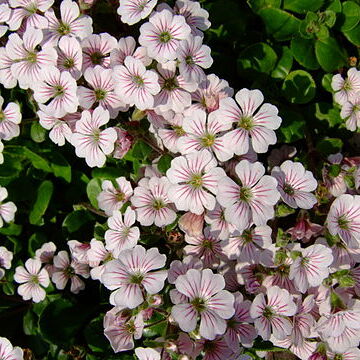Herbs annual or perennial. Stems usually caespitose, erect or diffuse, glabrous or glandular pubescent, sometimes glabrescent or base woody. Leaves opposite, linear, lanceolate, ovate, oblong, spatulate, or sometimes subulate or subfleshy. Flowers numerous, bisexual, small, borne in dichasial cymes, corymbs, or panicles, sometimes aggregated into capitula; bracts usually scarious, rarely leaflike. Calyx green or purple veined, white membranous between veins, campanulate or funnelform, rarely cylindric, glabrous or puberulous, veins broad, apex 5-toothed. Petals 5, white or pink, sometimes purple veined, oblong or obovate, longer than calyx, base usually cuneate, apex entire, truncate, or retuse. Stamens 10. Ovary globose or ovoid, 1-loculed; ovules numerous. Styles 2(or 3). Gynophore absent. Capsule globose, ovoid, or oblong, 4-valved. Seeds subreniform, compressed, tuberculate; hilum lateral; embryo annular; radicle prominent.
Herbs, annual or perennial (occasionally dwarf undershrubs outside of Australia), glabrous and glaucous, or glandular-hairy. Leaves opposite or pseudoverticillate, linear, linear-lanceolate, lanceolate, linear-oblanceolate or narrowly oblong, sometimes falcate; stipules absent; bracts scarious, at least at the connate base. Flowers in heads or dichasial cymes, rarely solitary, 5-merous, bisexual. Epicalyx absent. Calyx fused at the base, campanulate, 5-veined, green, with scarious seams between veins, 5-lobed. Petals 5, purple, pink or sometimes white, tapering gradually at base, exceeding calyx; coronal scales absent. Stamens 10. Ovary 1-celled; styles 2. Capsule narrowly obovoid, opening by 4 teeth; carpophore absent. Seeds several, asymmetric-pyriform to subreniform, flattened, tuberculate, rarely smooth.
Annual or perennial herbs, often suffruticose, with or without glandular hairs. Stems terete, thickened at the nodes. Leaves linear-narrowly elliptic, often somewhat succulent, opposite; petioles short, dilated at the base, opposite pairs shallowly connate at the base. Flowers small, mostly numerous in dichasial cymes. Calyx gamosepalous, without commisural nerves, 5-lobed, at least halfway down. Petals 5, white to pink, often with darker veins, patent, short-clawed, without coronal scales, gradually widening into the lamina. Stamens 10 (5), shorter than corolla. Styles 2 (or 3). Capsule subglobose, longer than calyx, dehiscing by 4 valves almost to the base. Seeds auriculate, verrucose or echinate.
Annual to perennial herbs; hairs glandular or 0. Lvs opposite, exstipulate, linear-subulate to lanceolate to spathulate, often glaucous, often sub-fleshy; cauline lvs connate in pairs. Fls in cymes, panicles or capitula; bracts leaflike to subulate; epicalyx 0. Calyx bell-shaped or top-shaped, rarely cylindric, not ribbed, 5-veined, 5-toothed with broad scarious nerveless commissures between the veins. Petals 5, white to pink, tapered or narrowly clawed, entire or emarginate; coronal scales 0. Stamens 10. Styles 2. Fr. a globose to cylindric capsule dehiscing by 4 teeth; carpophore very short or 0. Seeds auriculate, compressed.
Cymes dichasially branched, often diffuse; bracts scarious; cal short, campanulate to turbinate, 5-nerved, with scarious commissures, ebracteate; pet scarcely differentiated into blade and claw, without auricles or appendages; stamens 10; styles 2; capsule globose to oblong, opening by 4 ascending teeth; seeds compressed, subreniform; annual or perennial herbs, none native. 125, mainly temp. Eurasia.

